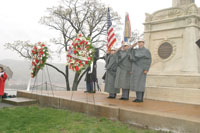History
West Point’s role in our nation’s history dates back to the Revolutionary War, when both sides realized the strategic importance of the commanding plateau on the west bank of the Hudson River. In January 1778, elements of General Samuel Parsons’ Connecticut Brigade crossed the river and climbed up to this spot. West Point has remained an active Army post since. It is, in fact, America’s oldest continuously occupied military installation.
General George Washington selected Thaddeus Kosciuszko, one of the heroes of Saratoga, to design the fortifications at West Point in 1778, and Washington transferred his headquarters to West Point in 1779. Continental Soldiers built forts, batteries and redoubts and extended a l00-ton iron chain across the Hudson to control river traffic. Fortress West Point was never captured by the British, despite Benedict Arnold’s treason.
Several soldiers and legislators––including Washington, Gen. Henry Knox, Alexander Hamilton and John Adams––desiring to eliminate America’s wartime reliance on foreign engineers, urged the creation of an institution devoted to the arts and sciences of warfare. President Thomas Jefferson ultimately signed legislation establishing the United States Military Academy in 1802. He took this action because he recognized that it could have civilian as well as military benefits for the nation.
Colonel Sylvanus Thayer, the “Father of the Military Academy,” served as Superintendent from l8l7-l833. He upgraded academic standards, instilled military discipline and emphasized honorable conduct. He appropriately made civil engineering the foundation of the curriculum. For the first half century, USMA graduates were greatly involved in the planning, surveying and conceptual design of many of the nation’s initial railway lines, bridges, harbors and roads.
After gaining experience and national recognition during the Mexican and Indian wars, West Point graduates dominated the highest ranks on both sides during the Civil War. Academy graduates, headed by generals such as Grant, William T. Sherman, Philip Sheridan, Robert E. Lee and “Stonewall” Jackson, set high standards of military leadership for both the Union and the Confederacy.
The development of other technical schools in the post-Civil War period allowed West Point to broaden its curriculum beyond a strict civil-engineering focus. Following the creation of Army post-graduate command and staff schools, the military academy came to be viewed as the first step in a continuing Army education.
In World War I, academy graduates again distinguished themselves on the battlefield. After the war, Superintendent Douglas MacArthur sought to diversify the academic curriculum. In recognition of the intense physical demands of modern warfare, MacArthur pushed for major improvements in the physical fitness and intramural athletic programs. “Every cadet an athlete” became an important goal. Additionally, the cadet management of the Honor System, long an unofficial tradition, was formalized with the creation of the Cadet Honor Committee.
Generals Dwight D. Eisenhower, MacArthur, Omar Bradley, Henry Arnold, Mark Clark, George S. Patton, Joseph Stilwell and Jonathan Wainwright are among an impressive array of Academy graduates who met the challenges of leadership in the World War II. The postwar period again saw sweeping revisions to the West Point curriculum resulting from the dramatic developments in science and technology, the increasing need to understand other cultures, and the rising level of general education in the Army.
Again, during the Korean and Vietnam wars, academy graduates met the challenges of command in positions ranging from young lieutenants to senior general officers.
In 1964, President Lyndon B. Johnson signed legislation increasing the strength of the Corps of Cadets from 2,500 to 4,400. To keep up with the growth of the Corps, a major expansion of facilities began shortly thereafter.
Although the strength of the Corps was temporarily reduced to 4,000 after the end of the Cold War, in recent years the strength has been increasing almost to 4,400 as the nation faces the global war on terrorism.
In concert with the increasing role of minorities and women in society and the military over the past four decades, greater numbers of minorities and the first women were admitted to the Corps of Cadets. Their presence has enhanced the quality and maintained the traditional representativeness of the institution.
In recent decades, the academy’s curricular structure was markedly changed to permit cadets to major in a wide range of subjects from the sciences to the humanities. With recent demands for increased cultural awareness, foreign language requirements and foreign exchange opportunities have been expanded.
As in the past, academy graduates continued to meet the challenge of leadership in the Persian Gulf War and more recently in Iraq and Afghanistan.
As the academy enters its third century, the institution continues to ensure that all programs and policies support the needs of the Army and nation today as well as in the foreseeable future. The academy, with its long and rich history, remains an energetic, vibrant institution that attracts some of America’s best and brightest young men and women. It offers a challenging and comprehensive array of opportunities while retaining its enduring commitment to Duty, Honor, Country.


